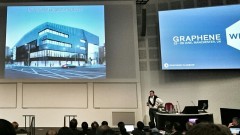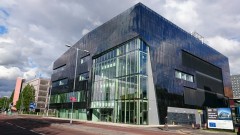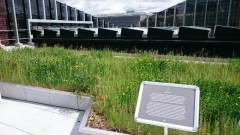The UK welcomed an influx of graphene experts last week as Manchester University’s 200+ researchers working in the field of 2D materials were joined by hundreds more for Graphene Week 2015. The event, now in its 10th year, has grown from a small European workshop into a five-day conference boasting over 600 attendees and pushing the University Place venue to capacity. The scope of the programme has expanded too; hexagonal boron nitride (hBN), molybdenum disulphide (MoS2) and other related 2D materials have joined graphene on the ‘menu’ of structures being explored by developers. Most recently, the conference has been co-ordinated by the Graphene Flagship – a European drive to capitalize on the many opportunities for 2D materials, which launched in October 2013 and has adopted Graphene Week as its annual conference.

Plenary update: Nobel Prize winner Kostya Novoselov briefed the Graphene Week 2015 audience on major developments in the field of 2D materials.
The European Commission (EC) has given graphene and related 2D materials research a huge boost through its Flagship initiative, but as Thomas Skordas, head of the EC’s FET Flagships Unit, reminded the audience during the conference opening – the funding is not a blank cheque for 10 years. The objective is to deliver economic benefits. So far, Graphene Flagship projects have generated 3x more publications compared with the Horizon 2020 average, but to achieve its long term goal the programme needs to capitalize on this research growth.
Connecting with industry
The challenge of taking graphene and related 2D materials from the lab to the market is a focus issue for TMR+ and its sister journal Translational Materials Research (TMR), and we were delighted to be invited to the Flagship’s latest Graphene Connect workshop, co-located with Graphene Week 2015, to join in the discussion.

New facility: the Graphene Connect networking event focusing on investment opportunities was held at the UK’s National Graphene Institute in Manchester.
The Manchester session was focused on investment opportunities in graphene and related 2D materials, and put the spotlight on start-ups and early-stage companies. Fittingly, the workshop took place at the recently opened National Graphene Institute (NGI) – a facility where academia and industry are co-located to promote translation of 2D materials from the lab to the market.
Presenters from the VC community included Achim Hoffman of IP Group. He picked up on the issue of media hype surrounding graphene, which has distorted expectations. One of the key messages from the session was the need to stay focused on the fundamentals such as the market, the technology and the infrastructure. “You’ve got to go back to basics,” summed up MTI’s Mark Rahn, who also spoke at the event.
Rahn presented a snapshot of companies operating in the graphene sector. Today, materials suppliers are putting resource into stepping up the value chain by offering functionalized products and formulations that are easier for customers to evaluate and integrate. “The real hard work is how you get from a good idea to a viable production process,” said Nigel Salter, Managing Director of 2DTech – a start-up supplying graphene nanoplatelets (GNPs).
Other industrial players at the workshop included BGT Materials, a 2D materials venture with a base in the UK and a sister operation in Taiwan. According to its UK manager – Liam Britnell – BGT has developed an environmentally-friendly way to process graphene-oxide (GO). Applications include barrier films for food packaging, which exploits the material’s very low oxygen transmission characteristics.

Hexagonal highlights: the National Graphene Institute’s carbon-black coloured cladding is patterned with graphene-shaped perforations.
Whether it’s packaging or microelectronics, materials firms need to understand their potential markets and make sure that their products and processes are compatible with their target industries. To accelerate this process, Applied Nanolayers (ANL) – which grew out of Leiden University – decided to break the cord from academia early on and moved south to base itself in the heart of the Netherlands’ chip-making ecosystem. The company provides wafer-grown 2D material such as graphene or hBN for a range of device applications.
Business briefing
The final panel discussion of the day, which featured Graphenea, Haydale and Flexenable, highlighted the many different routes for growing and repositioning businesses in the advanced materials sector – topics that TMR will be exploring in more detail through its journal section ‘Policy, funding and business strategy’.
- Graphenea began as a supplier of 2D materials for the research community, but the firm’s products also appeal to industry and in 2013 it won investment from Repsol – a multinational with activities upstream and downstream in the oil & gas sector. Most recently, Graphenea has been awarded Euro 2.5 million through the Horizon 2020 SME instrument – a phased programme of support to small-to-medium enterprises – which will allow the San Sebastian headquartered company to further scale-up its production capacity. The firm has a satellite office based in Boston, US, to strengthen its links with MIT and Harvard.
- Haydale has raised capital by floating on the London Stock Exchange, and recently acquired EPL Composites, which gives the firm an immediate route into this applications area. Haydale has built a strong case for the benefits of graphene functionalization through independent testing of its materials by the UK’s national measurement institute – NPL.
- FlexEnable was spun out of Plastic Logic to give the business more freedom to apply its expertise in printing transistors on plastic beyond the display sector. Its activities include consulting services to materials companies.
Meanwhile, back at Graphene Week
There was plenty of industry input at the main conference too with updates from Bosch, IBM and Alcatel Lucent, to name just a few of the big names eyeing up opportunities for 2D materials. TMR+ spoke with IBM’s Shu-Jen Han last year, and the message remains the same in 2015 – RF devices rather than digital logic are a stronger proposition for graphene. Telecomms could be a promising area for the material thanks to graphene’s consistent performance across a wide temperature range, and useful optical properties.

Smart space: The National Graphene Institute features a ‘high-rise wildflower meadow’ designed to improve roof function by providing a green space for people and pollinators such as bees, butterflies and hoverflies. For a video tour of the building, including the lab space, check out the YouTube clip from TMR+’s sister site physicsworld.com.
Alcatel Lucent has been working with partner AMO Aachen to investigate the potential of 2D materials in enabling highly-integrated photonic subsystems. The team has come up with a photodetector featuring CVD-grown graphene on a Si waveguide, which operates in the c-band (wavelength = 1550 nm) to support data rates up to 50 GBit/s.
The next Graphene Connect workshop is scheduled for early 2016 and will explore the topic of biosensors and implants. Graphene Week 2016 will take place in Poland next June.
Related articles from TMR
Graphene Connect underscores the importance of engaging SMEs in materials commercialization – Transl. Mater. Res. 2 010203 (2015)
Related stories from TMR+
Fullerex talks graphene pricing; identifies growth areas and supply targets

Pingback: Business school mines big data for clues on graphene commercialization | TMR+
Pingback: Mobile World Congress 2016: a big opportunity for graphene | TMR+
Pingback: Graphene Connect: bridging academia and industry | TMR+